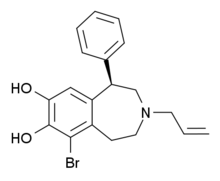6-(2-aminopropyl)benzofuran or 1-benzofuran-6-ylpropan-2-amine (6-APB), also known as Benzofury, is an entactogenic compound of the phenethylamine and amphetamine classes. It is similar in structure to MDA, but differs in that the 3,4-methylenedioxyphenyl ring system has been replaced with a benzofuran ring. 6-APB is also the unsaturated benzofuran derivative of 6-APDB.
Pharmacology

6-APB is a triple monoamine reuptake inhibitor with Ki values of 117, 150 and 2698 nM for NET, DAT and SERT respectively as well as being a potent agonist for the 5-HT2B receptor (Ki 3.7 nM). The subjective effects and structureâ€"activity relationship suggest that it is also a releasing agent.
The agonism for 5-HT2B makes it likely that 6-APB would be cardiotoxic with long term use, as seen in other 5-HT2B agonists, such as fenfluramine and MDMA. 6-APB acts as an agonist of the 5-HT2C receptor, which may be responsible for its appetite suppression. While 6-APB is an agonist at all three 5-HT2 receptor subtypes, its affinity for 5-HT2B is significantly higher. It is both more potent and more selective over other serotonin receptors than the reference agonist, BW723C86, which is commonly used for research into 5-HT2B receptors.
Effects

When taken orally (usually in the form of pills or powder) at recreational doses, 6-APB takes effect within 30 to 60 minutes. After this time, users report a feeling a sense of euphoria and energy. Effects plateau after approximately 2 hours, and effects may last up to 10 hours after initial administration. Users have also reported very strong feelings of empathy towards others, as well as musical euphoria (that is, a strong connection with the particular music they are listening to). While the drug never became particularly popular, it briefly entered the rave and underground clubbing scene in Britain before its sale and import were banned.
Law

6-APB is not listed under the Opium Law or the Medicine Act in the Netherlands, and thus currently legal.
6-APB is unscheduled in the United States, but not currently approved by the Food and Drug Administration for human consumption.
Certain countries contain a "substantially similar" catch-all clause in their drug law, such as New Zealand and Australia. This includes 6-APB as it is similar in chemical structure to the class A drug MDA, meaning 6-APB may be viewed as a controlled substance analogue in these jurisdictions.
6-APB is Schedule III in Canada as it is an analogue of MDA. The CDSA was updated as a result of the Safe Streets Act changing amphetamines from Schedule 3 to Schedule 1.
6-APB is unscheduled in France and Italy.
On June 10, 2013 6-APB and a number of analogues were classified as Temporary Class Drugs in the UK following an ACMD recommendation. This means that sale and import of the named substances are criminal offences and are treated as for class B drugs. On November 28, 2013 the ACMD recommended that 6-APB and related benzofurans should become Class B, Schedule 1 substances. On March 5, 2014 the UK Home Office announced that 6-APB would be made a class B drug on 10 June 2014 alongside every other benzofuran entactogen and many structurally related drugs.
6-APB is illegal in Germany since the 17th of July, 2013, when it was added to the Betäubungsmittelgesetz.
In Sweden, 6-APB is classified as "health hazard" under the act Lagen om förbud mot vissa hälsofarliga varor (translated Act on the Prohibition of Certain Goods Dangerous to Health) as of December 27, 2009 under SFS 2009:1095 making it illegal to sell or possess.
